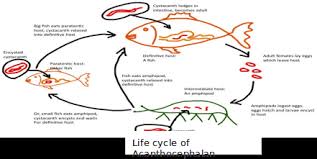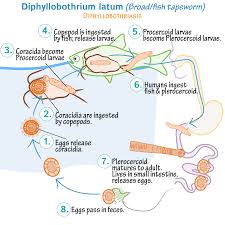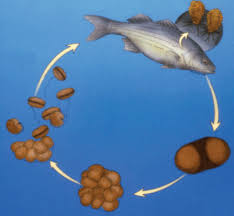Aquatic habitats provide ideal conditions for the maintenance and evolution of parasite life cycles. Water offers a physiologically stable and buffered environment, while its viscosity helps in the dispersal and survival of eggs and delicate free-living stages.
Parasites in fish can be categorized as either endoparasites, living inside the host, or ectoparasites, found on the external surfaces. In fish, gill surfaces are classified as part of the external environment because they are constantly exposed to the water.
Parasites exhibit various life cycle patterns, with some using a direct life cycle, where transmission occurs between definitive hosts, and others employing an indirect or complex life cycle that involves intermediate hosts.
Read Also: 5 Amazing Health Benefits of Triphala (Three fruits)
Life Cycle of Trichodinids

Trichodinids have a simple, direct life cycle. They rely on a single host and do not undergo alternation of generations or mass asexual replication off the host. Reproduction occurs through binary fission, which results in the splitting of cells and the creation of daughter cells.
These daughter cells initially have half the number of denticles as the parent, and new denticles are synthesized from the outer edge of the cell inward to restore the full number.
Trichodinids commonly attach to the gills, skin, and fins of fish. Some species are also found in the urogenital systems of fish and on the surfaces of invertebrates such as copepods and molluscs.
Transmission happens through direct contact between infected and uninfected hosts or by the active swimming of Trichodinids from one host to another. The parasites swim with the adoral surface facing forward and move laterally on surfaces with the adoral surface directed toward the substrate.
Life Cycle of Nematodes
The nematode A. crassus requires an intermediate arthropod host to complete its life cycle and become infective to its definitive host, the eel. Various arthropods can serve as intermediate hosts, but only Cyclops vicinus and C. albidus allow the parasite to develop into its infective stage.
Eels, from glass eels to larger individuals, are vulnerable to infection through the food chain. Heavier infections in eels often lead to a reduction in survival rates. In the definitive host, A. crassus inhabits the swim bladder, where gravid females can produce large numbers of eggs, with up to 500,000 eggs per individual. These eggs pass through the digestive system, and larvae hatch and attach to substrates.
Read Also: How Guava Fruits and Leaves Improve Female Fertility
Life Cycle of Cestoda (Tapeworms)

Cestoda parasites have a more complex life cycle involving two intermediate hosts and a definitive host, typically completed within 12 months. Tapeworms are hermaphroditic, and all species of this genus share similar reproductive structures, differing mainly in the shape of the internal seminal vesicle.
Eggs are released from the definitive host and complete their embryonation in water, where they hatch into motile larvae called coracidia. These larvae are light-sensitive and swim toward the surface, where they are ingested by the first intermediate host, usually a copepod.
In the first intermediate host, the coracidium migrates to the haemocoel and develops into the procercoid stage within nine days. When the copepod is ingested by the second intermediate host, typically a fish, the procercoid migrates into the muscles and viscera, developing into the plerocercoid stage. The final transmission to the definitive host, usually a pike, occurs when the infected intermediate host is consumed.
Tapeworm infections tend to peak in summer and early autumn, with egg laying occurring during the rainy season. Tapeworms can reinfect fish within the same year if temperatures are high enough, and adult parasites grow and mature during late spring and early summer, producing up to 1.75 million eggs per sexually mature worm.
Life Cycle of Acanthocephalans
Acanthocephalans complete their life cycle when their infective juvenile stage, known as cystacanth, is consumed by the definitive host. Copulation within the definitive host occurs within 24 hours of infection, and egg production starts four to eight weeks later, continuing for about two months.
Eggs develop through spiral cleavage, resulting in an embryo called an acanthor. The number of eggs produced is proportional to the size of the female. These eggs pass into the environment through the host’s feces and only hatch when ingested by the intermediate host.
Inside the intermediate host, the acanthor penetrates the intestinal wall and migrates into the haemocoel, developing through several stages. Some Acanthocephalans influence the appearance and behavior of their intermediate hosts to increase the likelihood of predation, ensuring the parasite’s transmission to the next host. Once consumed by the definitive host, the life cycle is completed.
Leeches: Life History and Biology
Leeches, such as B. tricarinata, feed on fish and other aquatic species, including tadpoles and adult anurans. Once engorged with the host’s blood, leeches detach and rest in protected areas like plant debris or under stones until their next feeding.
Reproduction occurs after several meals, and some leech species, especially those in the Glossiphoniidae family, exhibit parental care. They produce thin-walled cocoons, and after hatching, the offspring attach to the parent’s ventral wall in a brood pouch. The young remain in the pouch until their first feeding stage, at which point they are often brought to their first host by the parent.
Leeches in specific water systems may demonstrate host preferences. For instance, in Lake Victoria, B. tricarinata has shown a preference for Clarias lazera in the Jordan system of Israel and for Bagrus docmac in Lake Victoria. Depending on the availability of hosts, the life cycle of leeches can last from a few weeks to several months.
Parasites exhibit a variety of life cycle strategies, adapting to different environments and host availability. Managing aquatic habitats properly can reduce the risk of parasitic infections in farmed fish and aquatic wildlife.
Do you have any questions, suggestions, or contributions? If so, please feel free to use the comment box below to share your thoughts. We also encourage you to kindly share this information with others who might benefit from it. Since we can’t reach everyone at once, we truly appreciate your help in spreading the word. Thank you so much for your support and for sharing!
Read Also: The Effect of Solid Waste on Business Environments
Frequently Asked Questions
We will update this section soon.

